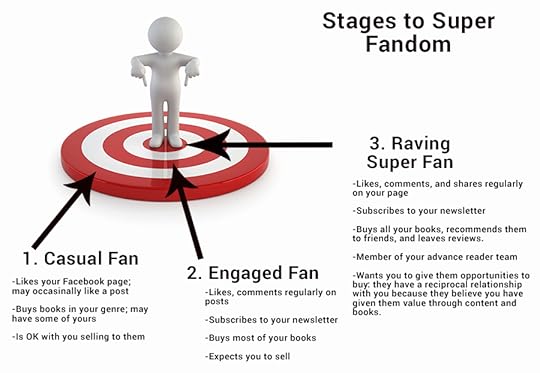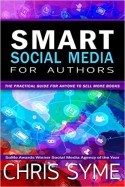Jane Friedman's Blog: Jane Friedman, page 138
December 31, 2015
The Self-Publishing Checklist: Editorial, Production, and Distribution
Whether you’re completely new to the publishing process or an old pro, it can be helpful to have a to-do list to guide your self-publishing project to completion, to ensure you don’t miss any important steps, and also to help you plan well enough to hit your target pub date.
I’ve created both a downloadable PDF handout and an interactive worksheet that you can customize for your book project.
Below I detail the distinct stages of the editorial, production, and sales/distribution process. My goal is to help you understand some of the assumptions I’ve made about the publishing process (which follows a traditional model), as well as where you can save time and expense.
The Editorial and Production Process
This process can be broken down into roughly three stages:
Editing
Design
Proofing
1. Editing
My checklist begins at the point where you have a reasonably final manuscript that does not require higher level editing or significant revision. While much depends on what level of editing your manuscript has already undergone, for most authors, I recommend seeking a formal copyedit: you send the manuscript to a professional freelance copyeditor, who will focus on style, grammar, and consistency issues—and might possibly do light fact-checking if needed (very useful for nonfiction).
A typical copyedit for an 80,000-word manuscript takes two weeks, but good copyeditors usually need to be booked a month (or more) in advance. Authors should give themselves at least a week, if not two, to review and make changes after the copyedit is returned.
2. Design
Depending on your project, you’ll have several stages of book design.
Front cover design. While the manuscript is being copyedited, you can begin on the cover design. Some authors are able to put together their own cover designs using tools such as Canva, but since your cover is often the number-one marketing tool for your book, hiring a professional designer is wise.
Before you hire a cover designer, I recommend doing some research and studying bestselling books similar to your own in genre, theme, or audience. Find at least two or three covers that you like, and write fifty to a hundred words explaining why these covers look good to you. This serves as the start of a creative brief you can give to your freelance designer, to help them create an appropriate cover for your book.
If you haven’t already, you should also finalize the title, subtitle, and book description that will be used at all retailers and on the back cover (for a print edition). It’s ideal if you have two or three versions of the book description: a very short one (25–50 words), a short one (50–100 words), and a longer one (250 words).
Obviously, it’s possible to produce a front cover for your book long before the editing is complete; all you need is a final title/subtitle, a final decision on your book’s trim size, and confidence in what the cover should look like.
Back cover design. Most ebooks only have a front cover design and no back cover design. If you’re producing a paperback or print-on-demand edition, then you’ll also need a back cover and spine. (Hardcovers will require yet another cover design to account for the flaps and increased spine width.)
Traditional publishers typically produce the front cover design first, and they don’t complete the back cover and spine until much closer to the pub date. It’s not possible to design the spine until the exact page count is known, and the page count may be in flux until the book’s interior is designed and laid out. The cover’s measurements are also affected by the printer you’re using, as well as the type of cover and interior paper.
However, if your page count is firm and unchanging, and you know which printers or POD services you’re using (e.g., CreateSpace or IngramSpark), you can have the entire cover designed as part of one process.
Important note: Many authors like to include advance praise or blurbs on the cover. If this is your intention, then you’ll need to start gathering these blurbs before the cover design process begins. Otherwise, you’ll need to instruct the designer to use dummy text in place of the actual blurb, and swap it out later.
Print interior design. If you’re planning a print edition and you have the time and money to invest, you may also want to hire a designer for the interior of your book. This may or may not be the same person who designs the cover—it depends on the freelancer and their skill set. Here are some considerations when deciding if interior design is worth the investment:
Books that are predominantly body text and nothing more (such as novels and memoirs), often do fine with very basic or template designs. Joel Friedlander’s Book Design Templates are an inexpensive way to produce a good-looking print interior using Microsoft Word or InDesign. His templates can also be used to generate your ebook files. Using a template system will dramatically cut down on the amount of time needed for book production—usually by one month.
Books that have a lot of elements or styles (usually nonfiction) may require a custom interior design. Especially if you have illustrations, graphics, or any color elements, you’ll want a designer who knows how to properly set up the file and ensure decent reproduction values.
When producing both a print and ebook edition, always keep in mind how you’ll ensure that both editions have the same final text if you’re using InDesign to produce the print edition. InDesign can export EPUB files, but it’s not necessarily a straightforward or simple process. A professional interior designer who knows how to export EPUB files from InDesign can be indispensable, or you can hire an independent ebook formatting professional to do it for you.
Usually, before the interior design process begins, the author comes up with a list of all the design elements that occur in the book. It looks something like this:
Chapter title and chapter opener
A head
B head
Bulleted list
Numbered list
Block quote
If you’re not sure how to come up with a list like this, your designer should be able to help or anticipate your needs for you. It’s best if they show you a sample of the design—or lay out a single chapter—before continuing with the entire book, so you can ask for revisions or adjustments to the design. Once the full book is laid out, the designer will send you the entire file to review for any final changes or tweaks. Once you’re confident none of the text will shift between pages, then you can send the file to an indexer (if you want an index prepared for the print edition).
Ebook design (EPUB file preparation). There’s not really an ebook design process—at least not for typical, reflowable ebook files (EPUB files). If your title has lots of special illustrations or visuals—or needs to have a fixed page layout—then you’ll want to hire a professional to prepare your ebook files for you. You’ll likely go through a process similar to the print interior design process—be sure to budget extra time in your schedule for this.
However, many authors do not hire out this work—and sometimes it seems there are as many ways to prepare an ebook file as there are authors. Some manage by using only Microsoft Word and the auto-conversion process applied by Amazon, Smashwords, Draft2Digital, and others. Some use software such as Calibre, Sigil, or Jutoh to prepare the files. This resource list offers a range of tools to consider.
If you’ve never before prepared an ebook file for publication, give yourself plenty of time to do so—at least one week. If this isn’t a process you want to handle yourself, some ebook cover designers will handle preparation of your ebook files.
3. Proofing
As you reach the end of the design process, you’ll have to decide how thorough your proofing process will be. Some authors proof their files themselves, and others send them out for a formal proofread. If you think your files are very clean, and very few errors have been introduced during the production process, then you might skip hiring someone. However, if you skipped the copyedit, and you’re the only person who has ever looked at the files aside from the designer, then it’s a smart idea to pay for a proofer before publishing.
The Sales and Distribution Process
This process can be broken down into roughly two stages:
Preparing your metadata
Uploading your files and going on sale
1. Preparing Your Metadata
Before you head off to CreateSpace or Amazon KDP to publish, it’s best to do all your research and legwork in advance as to how you will describe the book, how it will be categorized, what pricing you will use, and so on. That way, when you reach the publishing interface, you’ll have all the data at your fingertips and you won’t have to stop, think, go searching for missing information, or feel pressured into making a decision.
2. Uploading Your Files
This is perhaps the easiest and quickest part of the entire publishing process: making your book available for sale. In most cases, it won’t even take you an hour to get your book into the system and under review. With Amazon in particular, your book is often available and on sale in twenty-four hours. If you’re not ready to go on sale, then you can set the book as a preorder and input whatever pub date you want. (Amazon allows preorders up to ninety days in advance; Smashwords and others allow for one year.)
You should have the following files ready to upload for your print-on-demand edition:
Full cover layout file (PDF): if you’re using both CreateSpace and IngramSpark, you will need a different cover layout file for each, since they each will provide different measurements for you to use
Full interior layout file (PDF)
You should have the following files ready to upload for your ebook edition:
Front cover image: JPG, PNG, or other image format
Ebook file: EPUB will result in the best quality, but most retailers/distributors allow you to upload a Word document, among other common file formats
What’s Not Covered in This Checklist?
My checklist covers all the steps involved in creating your book and making it available for sale. However, it does not touch on any marketing concerns, such as sending out advance review copies, using social media prior to release or afterward, collecting endorsements, promoting a preorder, etc.
The interactive version of my checklist allows you to set any pub date you want, which will then automatically generate suggested deadlines for each step of the process. If you’d like to produce official-looking advance review copies (ARCs), then simply change the date to when you’d like to have ARCs. Alternatively, you can send out early, unproofed digital copies of your book to people who you’d like blurbs or publicity consideration from while you begin the production process.
Click here to download the PDF checklist for printing on letter-size paper.
Click here to access the interactive checklist and download/save it for your own files.
For More: My Most Popular Posts on Self-Publishing
Start Here: How to Self-Publish Your Book
How to Publish an E-Book: Resources for Authors
10 Questions to Ask Before Committing to Any E-Publishing Service
The Key Book Publishing Paths in 2015
December 30, 2015
5 On: Ashley Scott Meyers
Screenwriter Ashley Scott Meyers (@AshleyMeyers) discusses the critical writing lesson he learned over time, what it takes to make a living as a screenwriter, what it felt like the first time one of his scripts was produced, and more in this 5 On interview.
In his first three years after moving to Los Angeles, Ashley Scott Meyers wrote or co-wrote eight feature-length screenplays, earned his first few dollars as a screenwriter, and saw two of his original screenplays get produced: Meyers sold Dish Dogs, co-written by Nathan Ives and starring Sean Astin, Matthew Lillard, Brian Dennehy, Shannon Elizabeth, Maitland Ward, and Richard Moll, to 7.23 Productions. Independent producer/director Douglass DeMarco produced Meyers’s screenplay Reunion, which eventually found distribution in some art house theaters around the world. Over the years he has continued to option and sell screenplays.
Meyers has a master’s degree in mass communications with a screenwriting emphasis. His writing credits are listed on .
5 on Writing
CHRIS JANE: You have twenty-one loglines for completed, available scripts on your website. They range in genre from teen sex comedy to noir mystery to sci-fi to drama to romantic comedy to horror. Where do so many ideas for so many different kinds of stories come from?
ASHLEY SCOTT MEYERS: You know, I’m not sure. I like a ton of different types of movies, so I’ve written in a ton of different genres. It seems like some ideas are more appropriate for a given genre, so when I have an idea, I’ll work with it to find the right genre for it.
Which of your screenplays is closest to you or would mean the most to sell, and what inspired the story?
I think my baseball comedy is probably closest to my heart and would mean the most to see it get produced. It’s the story of a guy who loves baseball and wants to be a professional player but has zero athletic talent. So he has to compensate by working extremely hard. I often feel like this as a writer. It’s currently optioned, so I am hopeful.
When you finish the first draft of a screenplay, what’s your editing process like? Do you have trusted readers who offer feedback, or a hired editor? How many revisions does one of your screenplays typically go through before you feel it’s ready to present?
By the time I’ve finished a screenplay, I’ve already gotten a lot of notes on it. I am in a writers group where each writer puts up about twenty-five pages once a month, so I will be putting pages up as I write them. Keep in mind, too, I’m big on outlines, so I’ve spent quite a bit of time on an outline well before presenting any pages. Lately, once I’m done I will do a full read with actors and writers giving me notes to make sure it all works as one coherent screenplay. I will usually start sending it out shortly after that.
What I’ve found is that every producer who options a script will want some revisions, so rewrites will be done, but usually a little later, once I’ve found some interest.
What is it about screenwriting (vs. other forms of storytelling) that appeals to you?
I have always loved movies, and I’ve never really read a lot of fiction novels. So screenwriting seemed like a good fit for me. Even as a kid I loved movies and always thought it would be cool to write them. At some point I found Writer’s Digest’s Writer’s Market, and they used to have a section on production companies who would read unsolicited material. Once I found that, it all seemed possible, so I started writing almost immediately after that and started marketing before I was even done with my first screenplay.
What were some common writing mistakes you made in your early screenwriting days, and what challenge(s) do you experience now?
Early on I spent little time really considering the potential market for a script. I just had an idea I liked, and I would go write it. Starting out, I don’t think this is a bad idea because you’re not going to sell any of these scripts anyway. But as I matured and became more serious about actually being paid for my writing, I spent more and more time really trying to understand what scripts sold and why, and then I tried to let that influence my own writing as much as possible.
5 on Publishing/Selling
Your first attempt at selling your work was to send early material to listings you found in Writer’s Market. You later submitted query letters to ads in the back of trade magazines, which ultimately led to your first sale. But you also managed to get writing assignments through those ads. What was the nature of the assignments?
Typically what I would find in the back of trade magazines in terms of writing assignments were pretty low paid. Which was fine when I was starting out. For instance, in the late 1990s I was hired by a fairly well-established screenwriter to work in a group setting quickly writing up some of his leftover ideas that he didn’t have time to write.
I’m still in touch with this screenwriter, and he still has a script that I worked on that he likes. We often joke about trying to get it going again.
Tell me what it was like for you to experience, for the first time, one of your screenplays being produced.
It was bittersweet. The first screenplay I sold had been rewritten substantially, and I didn’t think that it was very good. So it was exciting, but some of the luster was taken off because of the extensive changes that had been made, which I thought really detracted from the piece.
I would say the greatest moment of pure, unadulterated joy was actually when I first optioned that script. My writing partner and I were paid $500 for the option, and we were young and naive enough to think that it was certain that this script was going to get made. At that point the producers were all compliments, saying it was perfect the way it was. It did get made, but as I mentioned it was so rewritten it was barely recognizable as our screenplay. But looking back at it now, the producers were very lucky to actually get the project going. Since then I have optioned dozens of scripts with very few actually getting made.
I will say this: the producers were a bunch of really cool guys, even though we didn’t see eye to eye on the script changes. My writing partner and I were on the set numerous times, and it was everything I thought it would be: exciting, fun, and mingling with celebrities.
In the book world, an agent is almost required. Do you have a screenwriting agent, and how beneficial (or not) is it to have one?
I’ve had several agents and managers over the years. None of them have done anything to help me sell or option any of my screenplays.
If you can get a good agent, then sure, they can definitely help. But I think screenwriters spend too much time on this and should spend their time trying to sell their scripts. I’ve found it easier to get producers to read my scripts than agents or managers. So that’s what I spend my time on. Perhaps one day a good agent will approach me.
How do you advise screenwriters with no credits to their name—but a screenplay to sell—to set themselves up online?
Try everything. There are tons of online services to help screenwriters—try them all. And don’t worry about spending a few bucks. It’s just money. You can make more. You need to find a marketing channel that fits your talents and skills. There are lots out there. I also have a free guide that is a nice primer to helping writers (with or without credits) sell their screenplays.
Someone says to you, “I want to make a quit-my-day-job living as a screenwriter.” What would it require to achieve that goal? How many hours a week would be devoted to it overall, on average, and how would you break it down in terms of the writing, building contacts, networking, etc.? What kind of person is least and most likely to succeed—not get rich, but pay bills?
I think before you quit your job you need to get into the routine of writing every day. I would recommend one hour of intensive writing per day five days a week. That’s realistic for most people, and if you stick to it you should be able to write one or two feature film scripts per year. Do this for a few years. Then you should have a few decent scripts. Once you have a script you feel is ready, I would start to spend twenty to thirty minutes per day (half of your one hour) marketing your screenplays.
Again, it’s going to take a little bit of time, but this one hour per day will add up over the course of years.
When it’s time to quit your job, you’ll know it. You’ll have optioned screenplays and be making some of your income from writing. You’ll know you’re close.
I think the type of person who is most likely to succeed is the person who has the discipline to actually do this. To me, that’s probably the single most important factor. Can you sit in a room by yourself for one hour per day, five days per week for several years without missing many days?
Thank you, Ashley.
December 29, 2015
5 Industry Issues for Authors to Watch in 2016
Over the summer I launched an email newsletter for authors, The Hot Sheet, in partnership with journalist Porter Anderson. We track the most important publishing and media industry news, and offer analysis specifically for an audience of authors. We include only what you need to know to make the best business decisions for your career.
In today’s post, I’m rounding up some of the most important headlines and stories that we reported on that every writer should keep an eye on in 2016.
If you’d like to receive my perspective on such issues (and more) on a biweekly basis, then consider becoming a Hot Sheet paid subscriber.
1. We’ll need to learn how to market books in a mobile-reading future.
A Wall Street Journal trend piece, “The Rise of Phone Reading” (Aug. 12, 2015), discusses new research from Nielsen showing a growing number of people read on their phones—leading to the conclusion that the future of digital reading will be on the phone, not tablets or e-reading devices.
A range of publishers, authors, and retailers—including Amazon and Apple—went on the record to share impressions of what the data (and anecdata) means. Some of the implications:
Apple and the iBookstore benefit greatly from mobile reading growth—for example, Kindle customers are increasingly reading books through their respective iPhone apps;
Publishers are thinking about phone display when designing covers;
Marketing for mobile readers means focusing more on email, Facebook, and websites—or anything that’s most often accessed through phones;
Emerging marketing strategies focus on places where people might download something while in transit (airports, hotels, and trains).
All this isn’t to say that print is going away. In fact, Judith Curr of Atria was quoted saying that the future of reading will be on both the phone and in print. But such trends may inform how your next marketing plan comes together, and they may also call to mind the increased sales of digital audio—see the next item below.
2. For optimism in publishing, take a look at audio storytelling.
Digital audiobooks are the biggest growth area for the book publishing industry. According to the Association of American Publishers, in 2014, the category grew about 27 percent in terms of units and revenue over 2013.
Similarly, podcasting is enjoying more popularity than ever. In 2014, the podcast Serial marked a renaissance for audio storytelling, with an audience of 40 million; last year, Apple reported podcast subscriptions had reached 1 billion overall.
And The New York Times just reported on a book deal that resulted from the fictional podcast Welcome to Night Vale. The creators of the show were drawn to podcasting because of the low barrier to entry and minimal cost.
However, earlier this month, MarketWatch published a misleading article reporting that audiobooks are outselling print. Well, yes and no. It is possible to find specific books that sell better in audio than print, but they’re the exception rather than the rule. Furthermore, the MarketWatch article looks at a very specific phenomenon: the growing fame of audiobook narrators and their impact on sales.
Both publishers and authors are putting more time, energy, and consideration into the creation of audiobook editions—and narrators of bestselling titles are becoming recognized and highly sought after. (Celebrities are also getting called in for high-profile projects.) Savvy authors treat audiobooks as unique and valuable creations in their own right, not as an afterthought.
3. Expect more tinkering with Amazon KDP, KDP Select, and Kindle Unlimited.
Amazon KDP is Amazon’s ebook self-publishing service, and KDP Select is their distribution option in which authors choose exclusivity with Amazon for ninety-day intervals in exchange for availability through the Kindle Unlimited (KU) and Kindle Owners’ Lending Library (KOLL) programs.
Over the summer, there was a lot of anxiety around announcements that on July 1, Amazon would begin paying KDP authors on a per-page plan for KU and KOLL borrows. Up until then, authors were paid if a user read 10 percent or more. Many writers had gamed that system, some with infamous fifteen-page erotica. Others broke larger works into smaller ones, all to get paid for “books” that weren’t.
Now, authors are beginning to see how the change to being paid per-page plays out. Hugh Howey and J.A. Konrath have posted their conclusions, Konrath with dollar figures. Both writers are supportive of the results. Konrath and Howey have sizable backlists, of course, and are in a special “indie bestseller” category. They’re called outliers by some for this reason. But if you consider one or both of them representative of indie author business practices, then the new payment model appears to reward quality (which sustains readership).
Then, for November, there was yet another change to KU and KOLL payouts—Amazon announced that per-page payments would differ based on the country in which the book was borrowed.
In other words, there’s not as much money coming from a subscriber in India as from one in the United States, and Amazon says that market factors “such as exchange rates, customer reading behavior,” and subscription prices are now to be reflected in how its per-page payouts are calculated for authors.
Last month, Michael Cader at Publishers Lunch analyzed Amazon’s payout changes between July and October 2015: “The total pool of money paid out has grown $900,000 since July (+8 percent)—while pages read have gone from $1.99 billion up to $2.58 billion (+30 percent).”
Expect more changes to come to KDP and KU payouts for self-publishing authors. When the ebook subscription service Oyster folded in September, we all saw a lot of “I told you so” going around because the all-you-can-read-plan has long been called an unsustainable business model by publishing insiders. You don’t have to be good with numbers to see how a $9.99/month subscription plan could become unprofitable with even moderate reading or sampling.
Keep in mind Big Five publishers do not currently offer their books through Kindle Unlimited (with extremely rare exceptions).
4. Sorry, but print book sales aren’t surging.
No doubt you’ve already seen the New York Times headline “E-Book Sales Slip, and Print Is Far from Dead” and encountered lots of speculation as to whether that story is accurate.
Not really. Hardcover sales are down more than 10 percent this year. As Michael Cader pointed out in Publishers Lunch, “Print sales are down more [than ebook sales] in percentage terms, and down more in aggregate dollars.” Across the board, overall sales volume hasn’t changed much: in 2015, print sales are up 2 percent, just as they were in 2014, according to Nielsen Bookscan data.
Also, Barnes & Noble (B&N) is not exactly flourishing in the way you would hope if print books are making a comeback. Since August 2015, their stock has dropped 67 percent. In 2013, the bookseller said they planned to close about one-third of their 689 stores over the next decade. Industry insiders speculate that, over time, shelf space or title selection may decrease at B&N.
But aren’t independent bookstore sales increasing—isn’t that a bright spot? Independent bookstore sales have not made up for the declines sparked by the Borders bankruptcy in 2011, despite positive media attention on their resurgence. Also, while American Booksellers Association (ABA) membership has grown, there are lots of ways to be a member of ABA: you can be a used bookstore, a book fair organizer, a mail-order catalog, etc. So take those “increases” with a huge grain of salt. Instead, focus on the shift taking place on where print books are sold, and keep your eye on Amazon’s share of the print book market.
5. Independent authors will focus more on international markets for growth.
At writing and publishing industry events alike this year, you’ll find growing attention and conversation on the growing global market for ebooks. For example, the leading organization for self-published authors, Alliance of Independent Authors (ALLi), has launched a Going Global campaign to search for meaningful international direction for authors.
There are three distinct types of opportunities for work in the global market:
Distributing English-language work in markets where English is a second language
Selling rights to a foreign publisher directly or using an agent
Translating English-language work and distributing directly to foreign countries
The first option is a no-brainer for self-publishing authors who use the major digital distribution services. Basically, authors only need to give the retailer or distributor permission to make their English-language work available for sale in other territories, assuming you hold the rights.
The challenge, however, is that ticking a box—for the Philippines or Cameroon or France—means only that your book appears in that country’s online store; it doesn’t mean that readers know your book exists. Visibility and marketing in another country remains a tough nut for authors to crack.
The second option (selling rights) takes time and energy without an agent, and is typically outside the ability or expertise of the average author. There are services like IPR License that are trying to make it easier.
The third option—paying to have work translated—is the highest risk. However, more and more services are emerging that help authors navigate the foreign rights and translation landscape (such as BabelCube and FibeRead). However, while there is opportunity, selling translations entails high risk and potentially low return on investment.
If you enjoyed this post, then sign up for a free 30-day trial to The Hot Sheet, my biweekly newsletter for authors on the the publishing industry.
December 21, 2015
Best Practices for Author Facebook Pages and Groups

by West McGowan | via Flickr
In today’s guest post, Kirsten Oliphant (@kikimojo) discusses how to effectively use Facebook pages and groups. Download her free Facebook workflow cheatsheet.
As one of the older students in my MFA program at twenty-seven, I was forced to join Facebook. Without it, I would have missed out on important communications with my fresh-out-of-college classmates. (Like what time to meet at the bar after workshop.) By the time I started utilizing Facebook as a platform-building tool, it was in the post-apocalyptic landscape after the algorithm change.
If you don’t know about this shift, Facebook stopped showing page updates in the newsfeed of those who Liked the page. Instead, Facebook created an algorithm that neutered organic page reach, supposedly to increase user experience. (Which not-so-coincidentally increased the use of paid ads and boosted posts.)
To get a real sense of the impact of the algorithm, here is a quick example:
I have about 2,600 Likes on my page, but the last link to my blog showed up in only thirty-one user’s feeds. This means about 1.5 percent of my audience saw my post.
With this kind of algorithm, is it worth your time to utilize Facebook for your platform?
Yes!
As of 2015, Facebook has 1.55 billion active users per month. You can still find and connect with an audience on Facebook, but you may consider using a Facebook group instead of—or in conjunction with—a Facebook page.
Because I think we are all exhausted trying to keep up with all the social media platforms out there, I will highlight the functions of pages and groups so you can see what might work best for your goals. Creating a streamlined time management breakdown is not as simple as it is on Twitter, but I will also suggest a workflow to help you manage both groups and pages. Even if you choose to do both, you can still effectively manage your time.
Facebook Pages vs. Facebook Groups
Many people expect authors, bloggers, or public figures to have a page. A page functions with the creator at the center. Interactions come from and return to her like spokes of a wheel. The currency of a page is the number of Likes, but that number isn’t necessarily a good metric of engagement or success.
To see growth and engagement, pages need consistent and frequent posts. That means pages are a lot of work with no guarantee that people will see it to appreciate it. Some people choose not to use pages for this reason, or they simply set up a Facebook page like a landing page with basic information, and send visitors to an email list, blog, or Facebook group instead.
A Facebook group functions more like a web, where connections don’t have to move in a linear way from the creator at the center. The moderator often initiates conversations, but members interact more with one another and can also be active contributors. Groups form around a topic, blog, book, area of interest, or even simply around a person. Groups are not (yet) affected by an algorithm shift, which means that your members will see more of your posts than people who Like your page.
Groups can be very effective even if they are small. My podcast’s Create If Writing group has under 150 members, but is far more active than my page. The last link to my content was seen by thirty-two people (about 20 percent of the group) and had several Likes and comments.
Rather than simple numbers, interaction and the sense of community is the metric for successful groups. Some writers utilize Facebook groups for book-launch teams, beta readers, or thirty-day challenges, and some use them as a private group exclusively for email subscribers.
Facebook Pages: Best Practices
To get the most out of your page, use the same profile photo you use on all social media and create a great cover image. If you aren’t a whiz with Photoshop, use free tools like Canva, which has a template size specifically for Facebook covers. Remember to look at Facebook first to see where the wording falls before you create the image. See how my site name gets hidden below by the buttons?
Tip: This post from Buffer has all the current social media sizes! But keep checking back, as they sometimes change.
Make sure you have a call-to-action button. (Mine is the “Sign Up” button above.) Facebook will prompt you as you set it up. A sign-up for your email list is a great option to connect in a more lasting way with fans.
Use keywords in your description and your bio so that your page will show up in search. You can also pin a message to the top by holding your mouse over the triangle at the top right corner of your post and selecting “pin post.” Create a post with a welcome and eye-catching image, or change it out as you have promotions.
Pages work best with lots of activity. Holly Homer from Kids Activities Blog found unprecedented success by posting upwards of twenty times a day. That’s unrealistic for most people (unless you have a virtual assistant or a clone), but the point is this: quality activity breeds interaction. Holly grew the QuirkyMomma page from a few hundred thousand Likes to over a million in a year without using ads.
Tip: A good start for a page would be to schedule six to eight posts per day if you want to grow your reach. An effective breakdown might be two links to your content, three or four to other people’s content, and one or two posts asking a question that sparks discussion. Try a mix of images, text, links, and video uploaded straight to Facebook.
Pages allow you to schedule posts, which makes frequent posting much more manageable. Many social media tools do this for you, but Facebook responds better to native shares from within Facebook itself. (And if you want to have better reach, do what Facebook likes!) Just click the little arrow on the Publish button and you’ll see this option.
Pages provide fantastic free analytics that can help you discover what works best for your audience. In the top navigation bar of your page you can view Insights or Publishing Tools to see how your posts have performed.
Another helpful tool is Pages to Watch, found near the bottom on the Insights page. You can choose other, similar pages and gauge how you are doing in comparison. Seeing how similar pages find success can give you ideas of what might work for your audience. In the screenshot below, notice how engagement correlates to the number of posts per week!
Facebook Group: Best Practices
As with your Facebook page, have a cover image that is easily recognizable in relation to you, your blog, or your books. The sizing is generally similar to that of Pages, but the words appear in a different place, and there is no profile photo.
One of the most important parts of setting up a group is choosing the right settings. You can choose to have the group open, closed, or secret.
Open means anyone who finds the group can see every post and member.
Secret means no one can even see that the group exists.
Closed means the group will show up in search and members are visible, but no one can see posts without joining.
Closed is a great option to allow for growth while also providing a safer space for people to talk. Here is a glance at my settings:
Note: The default setting allows any member to add or approve members, so switch this off. Otherwise anytime anyone wants to join, every member gets a notification, which you don’t want.
Group moderators set the culture and tone for the group, so be intentional. Pin a post to the top that talks about group expectations and guidelines. Sometimes groups can get spammy with members going overboard with self-promotion. One solution is to have share threads one day a week. I have seen other group moderators allow members to share links to their content, but only if it is specifically relevant to the group.
Be clear about the expectations. Don’t be afraid to delete comments or posts that don’t jive with the culture you want to create in the group. Remove users who don’t abide by your guidelines. You want to have a community where people talk to each other, but you also get to decide what should be included. The more intentional you are in communicating this, the better group culture you will create.
Suggested Workflow for Facebook Groups and Pages
The main bulk of time on your page will be scheduling shares. The main bulk of your time in your group will be interacting with people. Currently I probably spend 90 percent of time on my group and 10 percent on my page. Think about your goals, set a system in place, and stick to it. Here are my systems that work for my current Facebook strategy.
Facebook Group Workflow
Budget about twenty minutes a day over three or four separate time slots. Do all five steps each time.
Post a link, question, or image.
Respond to any interactions on older posts.
Approve any new members.
Check wall for member posts.
Respond to any comments on the link you posted in step 1.
I start every morning with a post in my group to promote discussion. I’ll sometimes ask for goals, what people are working on, what they think about a particular article, or something that gets people talking. I do this first, so while I do other group maintenance, comments come in and I can respond in that same time block. Images like the one below can be particularly effective at promoting discussion.
I post links to my own content usually once a day and sometimes will drop a quick link in to something I’m reading without taking the full steps above. At night I check back to see anything I’ve missed over the day. If I have any bonus time to spend lost in social media, chances are I spend it in my group, not on my page.
Facebook Page Workflow
Budget about five minutes a day, plus one twenty-minute slot once a week.
I typically schedule the bulk of my weekly posts in one sitting. Working in batches saves me time and ensures that I will have posts going up on my page. Each day I check notifications for the group and respond when I have interactions. Sometimes I will post additional content as I run across relevant links.
Tip: Use the Facebook app on your phone for pages so that you only see notifications for your page and aren’t tempted to respond to any personal interaction with your profile.
Because your fans will not see all your posts, you will likely have less interaction here than in a group. This makes it all the more important to interact when you do have comments to keep the momentum. Even a few likes and comments can organically boost a post’s visibility.
I look at my analytics before scheduling out my weekly shares. Generally speaking, posts that already have great reach (think Buzzfeed videos or popular news stories) will have good reach. It’s a best practice to share a link from that site, not just share the post someone else has shared on Facebook.
Because finding great content can also be time consuming, create a system for collecting links and content to share. Create a document in Evernote to drop links for later. Make a list of the top ten sites with quality relevant content. You can also use the Pages to Watch feature in your Insights to see what is working for those similar pages and share that content.
Another easy way to collect content for easy sharing is to create an interest group in Facebook. The far left column on your home screen has Interests near the bottom. You can follow someone else’s list or create your own with pages or blogs that post relevant content. Anytime you are looking for something to share with your group or on your page, you can scroll through to look for links.
To Facebook or Not to Facebook
Should you use Facebook? Yes.
Should you use a page, a group, or both? That depends on your goals.
It is not a bad idea to have both a page and a group, but I feel strongly that the platform-building aspects of social media should not replace our writing time. They can be an easy distraction when their function is to support our writing. Set your own system in place for how you will get the most out of your page and/or group without falling into the Facebook abyss.
Have you used both Facebook groups and pages? If so, which have been more effective for you?
Note from Jane: For more from Kirsten Oliphant, follow her on Twitter (@kikimojo), and don’t forget to download her free Facebook workflow cheatsheet.
December 18, 2015
Overcoming My Fear of Twitter

by Karen | via Flickr
In today’s guest post, Chris Jane (@chrismjane), who writes the biweekly Q&A series 5 On, discusses overcoming her fear of joining the Twitterverse.
Like many independent authors, I’ve long understood the value of Twitter as a networking tool. Even so, regardless of what I “understood,” and no matter what any experts said, I would not embrace it. I recently realized I can blame my child-self for that.
As a kid in middle school, I was the wrong kind of nerd. Skinny, big teeth, goofy-looking. I hated being looked at. The thought of walking into a crowded cafeteria at lunchtime was so unnerving it became my daily mission to be the first one out of the classroom when the lunch bell rang. That way, I could be one of the first to the lunch room. As the end of the class period drew near, I’d start watching the clock. At the first in the upbeat series of chimes (an unwelcome revision to the harshness of the straightforward bell), I’d launch out of my desk and fly through the hallway, take the stairs two at a time (I became a pro at this), and make it to the cafeteria hot-lunch line before even the sack-lunchers had had time to take their seats at one of the long tables.
A couple of decades later, I still have the same anxiety. It makes me very uncomfortable to enter cafeterias, cafeteria-style restaurants—and crowded classrooms and buffet lines and nearly full airplanes.
And, it turns out, Twitter.
Though I’ve maintained accounts over the years (if “maintain” means the same thing as “not deleting”) because they say that’s what writers are supposed to do, I’ve always been quick—even proud—to say “I hate Twitter.” But why? And what does that mean? My best answer is Yoda’s: “Fear leads to anger. Anger leads to hate.”
It occurred to me that Twitter resembles an online cafeteria: a bustling environment crowded with an assortment of different-sized cliques, the amount of chatter upon entering so overwhelming a virtual cacophony that it seems impossible for any one person to be heard over any other one person.
What business did I have thinking I could add anything to that? I would never be the cool kid Neil Gaiman (@Neilhimself) is. I’m nowhere near as smart as popular “geek” Neil deGrasse Tyson (@neiltyson). And I’m no @GuyInYourMFA class clown.
Hitting the “Tweet” button after agonizing over what my 140 (or fewer) characters would say felt to me like calling across the cafeteria to get the attention of a group of kids I didn’t know and had never hung out with. I was afraid of being heard, being seen. (“Oh. My. God. She’s actually trying to talk to us, bless her heart!”) I was also afraid of not being heard, not being seen.
All of these factors combined to form a clear and simple truth: Twitter was not for me, and I was not for Twitter. I would use it occasionally to share links and respond to direct tweets, but that was it.
Then, one day in early December, I came across Engaging Audiences through Twitter in 15 Minutes a Day by Kirsten Oliphant (@kikimojo). I saw the headline, thought, “Fifteen minutes? Riiight,” and clicked the link. At the first mention of Hootsuite and Buffer, I was out of there. Forget the social anxiety synapses Twitter liked to tickle—anything requiring me to learn an entirely new category of social media language was something that would take far too much time away from …
Well, from what, really? Had I not spent two hours that morning not-really-listening to a political yammer show? Did I not have one little free half hour sometime between my writing quit-time of four o’clock and dinner at eight-ish? Yes. Yes, I did.
Still, what was the point? Millions of tweets fly at and past each other. What chance could I possibly have of being appealing to anyone when all the appealing people were already out there doing their own appealing things?
The answer to that, I think, is one of the early pieces of advice parents give their kids that’s too easily discarded or forgotten: there’s no reason to mimic or compete with any other person’s “thing,” which is effective precisely because it is that person’s own unique thing; just do you.
Important for kids to know, and equally important, I think, for this emerging Twitter user to know. I’m not sure, yet, what my thing will be, but I’m looking forward to finding out. Not only because a second stop at “Twitter in 15 Minutes” revealed the overall process to be an intriguing challenge far less complicated than my defensive shutdown would let me see, but because of the exceptional nature of the internet: in the real world, you can step outside of your house and smile and wave, and it will be known that you’re there, you’re alive, you’re a being in the world. But if you aren’t actively present and engaging online, in that world, you—your books, your businesses, your blog entries, your thoughts—simply don’t exist.
Join Chris Jane on Twitter (@chrismjane) and check out her 5 On interview series.
December 16, 2015
5 On: Elisa Lorello
In this 5 On post, bestselling author Elisa Lorello (@elisalorello) discusses authenticity, using social media to connect with readers, rejection, and the differences between self- and traditional publishing.
Elisa Lorello earned her bachelor’s and master’s degrees from the University of Massachusetts–Dartmouth and taught rhetoric and writing for over ten years. In 2012 she became a full-time novelist and is the author of the Kindle bestselling novels Faking It, Ordinary World, She Has Your Eyes, Why I Love Singlehood (co-authored with Sarah Girrell), and Adulation. In 2013, she published a memoir titled Friends of Mine: Thirty Years in the Life of a Duran Duran Fan.
Elisa has been featured in the Charlotte Observer and the Raleigh News & Observer and was a guest speaker at the Triangle Association of Freelancers 2012 and 2014 Write Now! conferences. She continues to write, speak, and teach about her hybrid publishing experiences and topics in the craft of writing and revision. She currently lives in Montana with her husband-to-be.
5 on Writing
CHRIS JANE: Books on writing as a craft come from a wide variety of successful authors—Dean Koontz (How to Write Best Selling Fiction), Josip Novakovich (Fiction Writer’s Workshop), David Corbett (The Art of Character), Stephen King (On Writing: A Memoir of the Craft), etc. What is your personal favorite, and is it the same book you would recommend to a new writer looking for instruction?
ELISA LORELLO: On Writing, which my twin brother gave to me one Christmas, was the first book I read that took my writing to a new level. I had already seen exponential changes due to grad school classes I was taking in writing persuasively and learning rhetorical appeals, devices, etc. Strunk & White’s The Elements of Style also left an impression on me in terms of honing language, as did Donald Murray’s The Craft of Revision. But King’s book gave me the confidence I’d never had as a fiction writer.
I’d taken creative writing classes before, but those consisted of workshopping and critiquing stories without actually breaking down and explaining the elements of fiction, such as dialogue, narrative, sensory description, etc. On Writing gave me a simple understanding of writing as a craft for the first time, and, better yet, made novel writing do-able and fun. Every semester I assigned chapters from it to my English 101 classes, and hands down it was always their favorite. I’d put it on the recommended reading list rather than the required, but after the excerpts, many of them—even those who didn’t particularly care for reading or writing—would buy it and read it cover to cover. They found it to be no-nonsense, non-intimidating, and useful in their academic as well as creative writing, as did I.
On Writing is also one of those books I keep going back to just to give myself a refresher or to fall in love with writing all over again. Even something as simple as “If you want to be a writer, you must do two things above all others: read a lot and write a lot. There’s no way around these two things that I’m aware of, no shortcut” continues to challenge me—do I read enough? How much is enough? How does what I read affect what and how I write? What does “well read” mean? And my Why I Love Singlehood co-writer, Sarah Girrell, and I always like to remind each other, when giving feedback on each other’s drafts, “Stephen says the adverb is not your friend.”
I continue to recommend On Writing, as well as Nathan Bransford’s How to Write a Novel: 47 Rules for Writing a Stupendously Awesome Novel That You Will Love Forever, although I think that one is more targeted for beginners.
Beyond word-count or page-count goals and time limits, which you’ve said can stump your writing, what is the biggest saboteur to your creativity, and how do you combat it? And, conversely, what makes you feel the most confidently creative and productive, excited to write?
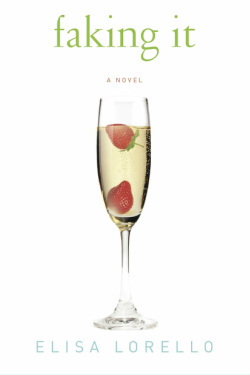 Writer’s block is the number-one saboteur to my creativity. If it takes hold, it can be as little as a few days and as long as a few weeks to get over it. It’s absolutely fear-based for me, mainly that what I’m writing isn’t good, will never be good, was never good to begin with. Underneath that, of course, is the fear that, as a writer, I am no good, will never be good, was never good to begin with, and I’m gonna die alone, too. It can happen at any stage of the drafting and/or revising process, sometimes before I even begin a new novel. Heck, I’m already stressing about writing my wedding vows, and I’m not getting married until fall 2016.
Writer’s block is the number-one saboteur to my creativity. If it takes hold, it can be as little as a few days and as long as a few weeks to get over it. It’s absolutely fear-based for me, mainly that what I’m writing isn’t good, will never be good, was never good to begin with. Underneath that, of course, is the fear that, as a writer, I am no good, will never be good, was never good to begin with, and I’m gonna die alone, too. It can happen at any stage of the drafting and/or revising process, sometimes before I even begin a new novel. Heck, I’m already stressing about writing my wedding vows, and I’m not getting married until fall 2016.
So what is “good”? In terms of my own content, it’s about what engages me as the reader as well as the writer. If I’m telling a story that moves me or connects to me in some way, then I’m on the right track in terms of having the same effect on readers. So what makes me eager to get to the next page, and the next, and the next? For starters, I love when I write something that makes me chuckle every time I read it. It comes down to style, the manner in which I write it—the words I use, the patterns and rhythms those words form, the precision (cutting out what’s not needed), the rhetorical shape, and so on. The story/narrative is very much playing out like a movie or TV show in my head when I’m writing. Thus, I love dialogue and “filming” the scene in terms of the visual, be it through action or sensory description. But I equally love getting inside my characters’ heads and figuring out what makes them tick, why they behave the way they do. That’s my psychology degree at work. I have therapy sessions with them throughout the course of drafting.
When I drafted Faking It, my first novel, I wrote on the cover page: “I wrote the book I wanted to read.” That’s been my mantra ever since. Ultimately I have to write a novel I would pick up if I found it on a table or an endcap display in a bookstore or on a library shelf. I don’t ever think in terms of genre or commercial appeal. However, there are a few specific, personal readers I want to please. My fiancé, also a bestselling author, is one of them. My Why I Love Singlehood co-writer, Sarah Girrell, is another. If Sarah likes it, then I’m on the right track.
What makes or keeps me excited, productive, and/or creative is when a story or scene idea just won’t let go of me. It’ll be the first thing I think about when I wake up, it will stay with me all during my shower or a long drive, and I’ll be itching to stop whatever I’m doing just to get it on the page. When I’m in that zone, the writing may not be at its best, but I’ll be in the right space in my head to make it its best. Reading a book or watching a movie/television show that has captivated me may also inspire and motivate me to write.
Anyone who’s followed your Facebook feed knows how big a fan you are of Aaron Sorkin, his writing of dialogue in particular. What is it about his dialogue style that stands out to you, and what are the keys to creating believable, realistic dialogue?
Actually, on the subject, should “believable” and “realistic” even be considered ultimate goals beyond the obvious goal of moving the story forward? Consider that almost all of Sorkin’s characters, much like the characters in The Gilmore Girls, seem—at least in The Newsroom, The West Wing, and Sports Night—to have many words to say about many things in a way most regular people don’t (one Salon article calls Sorkin’s style “double-time banter”). Or is there more to it than realism?
I love Aaron Sorkin’s dialogue because he and I share a similar approach: it’s like music to us. If description is the visual experience of writing/reading, then dialogue is the audio experience. When I’m writing dialogue I’m very attentive to the way it sounds rather than the way it reads. I’m thinking about rhythm and intonation and syntax. I’m not trying to achieve “real” dialogue because actual conversations are full of pauses in thought, tense shifts, interruptions, grammatical errors, etc. If you read transcripts of conversations or something like a Google Chat, they’re typically hard to follow and not particularly as interesting as when the conversation took place in real time.
Rather, what I want to achieve is authenticity. Authentic dialogue isn’t about the way real people speak, but rather what is real to the characters’ voices and experiences, and what serves the story. Good dialogue advances the story. It also reveals characters’ traits and speaks to their truths, even if they’re lying through their teeth. Gilmore Girls is a great example of that, as are all the Sorkin titles you mentioned.
Here’s an example of ho-hum dialogue:
“I’m afraid I love you, George,” said Laura.
“I’m afraid I don’t feel the same, Laura,” said George.
Here’s the same dialogue exchange, completely kicked up in terms of voice and character and conflict:
“Under different circumstances, when I’d be less vulnerable and you’d be less likely to be a complete ass about it, I might be willing to say I love you, George. Especially if I’d first had a couple of glasses of wine.”
“I really enjoy talking to you during commercial breaks in the football game,” said George, “but I’m not sure there’s a future in that.”
Dialogue doesn’t have to be fast to be good, but it is one approach. Scandal, for example, is downright frenetic in the speed of its dialogue. It’s The West Wing on twenty cups of coffee. It’s a bit too much for me, personally, but it certainly serves the show.
Nathan Bransford says dialogue “should be a conversation that you want to eavesdrop on.” I love that.
When I wrote my memoir, Friends of Mine: Thirty Years in the Life of a Duran Duran Fan, I unearthed the fan fiction I’d written when I was about fifteen or sixteen years old. I hadn’t read any of it since the late eighties, so I was ready to cringe. And while some of it was indeed cringe-worthy, I was really impressed by the dialogue. It was exceptionally mature for its age, and possessed many of the stylistic traits I use to this day without my consciously knowing it then. Thus, what I thought had been a recently developed ability thanks to watching so much Sorkin-penned stuff was actually an innate talent, and that pleased me. It’s the part of the novel-writing process that comes easiest to me.
Here’s the irony, though: you’d think that would make me good at screenwriting, given how many storytelling cues I take from film and television. I struggle with controlling too much in a screenplay, as if I’m trying to do the director’s and camera operator’s jobs. The bottom line is that I like narrative as much as I like dialogue.
Oh, and by the way, I’m an even bigger Nora Ephron fan than I am an Aaron Sorkin fan. She wrote articles, essays, plays, films—all smart and sometimes humorous and clear and concise and every word belonging. I miss her and wish I’d had an opportunity to meet her before she passed.
When writing Faking It, you were just out of grad school and, you’ve said, throwing all of your favorite rhetorical devices into the story. What is your least favorite rhetorical device, and what is your favorite?
I’m not sure there is any specific device I don’t like—at least none comes to mind—but I absolutely have a few that I use repeatedly. One is amplification (“She wanted ice cream. Soft ice cream. Ice cream so soft and smooth it formed snow-topped peaks.”). Another is antithesis, in which “two opposite ideas are put together in a sentence to achieve a contrasting effect.” (“He was more blue-blooded than blue collar, preferred Bach to Beatles, condos to country living.”) That example also showcases how much I adore alliteration. Occasionally I’ll use those modes of discourse still taught in some English 101 classes. For example, process analysis, in which I describe how something is done. In my new novel, Pasta Wars (launching in May 2016), Katie learns how to make pasta from scratch, and we see her going through each step of mixing the dough, kneading it, rolling and cutting it, and then cooking. I also lean toward compare and contrast.
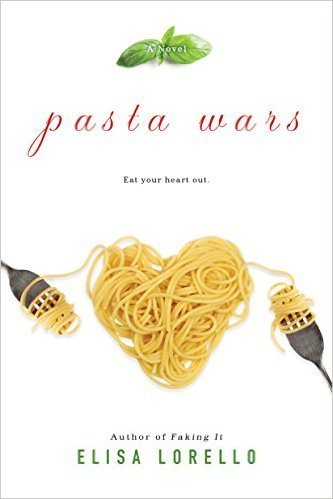 I like playing with rhetorical genres as much as I do the devices. In almost every novel I’ve written, I include a text within a text—a letter, an essay, a list, an excerpt from a screenplay, etc. I didn’t include any recipes in Why I Love Singlehood or Pasta Wars. For some reason, seeing the actual recipe doesn’t really work for me as much as describing the process of making the food, and the feeling/experience that accompanies it. Because of my rhetorical training, I think about writing in terms of audience, purpose, style, etc. rather than plot, theme, climax, etc. In the same way I’m not consciously thinking about writing a bestseller or a mystery novel, I’m not thinking, “Hey, I think I’ll write a compare-contrast piece.” Rather, I just want to tell the best story I can in the best way that will engage readers.
I like playing with rhetorical genres as much as I do the devices. In almost every novel I’ve written, I include a text within a text—a letter, an essay, a list, an excerpt from a screenplay, etc. I didn’t include any recipes in Why I Love Singlehood or Pasta Wars. For some reason, seeing the actual recipe doesn’t really work for me as much as describing the process of making the food, and the feeling/experience that accompanies it. Because of my rhetorical training, I think about writing in terms of audience, purpose, style, etc. rather than plot, theme, climax, etc. In the same way I’m not consciously thinking about writing a bestseller or a mystery novel, I’m not thinking, “Hey, I think I’ll write a compare-contrast piece.” Rather, I just want to tell the best story I can in the best way that will engage readers.
Reading Faking It now, I can see how idealistic I still was, being fresh out of grad school. It’s partly embarrassing, partly endearing. However, scholar Peter Elbow, whom I call the Paul McCartney of rhetoric and composition, read Faking It and loved it, so that was a highlight for my previous career and my present one.
Why do you write what you write?
In Faking It, I quoted Picasso’s “Art is a lie that makes us realize the truth.” That’s very much what fiction writing is for me. I write to tell a truth that needs to be told, or a story that wants to be born. It takes hold of me and won’t let go until it gets on the page. That “truth” isn’t necessarily a conscious thing, and it’s not the starting point for me. I don’t think, “I want to write about conformity,” but I might find myself wanting to tell a story about a woman who discovers she got married because she thought she was supposed to, and thus finds herself too afraid to leave her marriage because of what other people might think.
Just about all my novels gravitate toward themes of authenticity and home. Home could be an actual place or a state of mind. I tend to play with authenticity through names. Some of my characters have changed either their first or last names, prefer a nickname to a full name, hate their name, are closely associated with their name, etc.
Additionally, I take “write what you know” to heart. That doesn’t have to be literal advice (although sometimes I use it as such), but some aspect of the story and/or character(s) is relatable or familiar to me, either through an interest, an experience, or a memory. I don’t write autobiographically in terms of basing an entire novel on my life, but I may repurpose a memory or an event to suit a scene in a story. For example, I often talk about how the scene of Andi grocery shopping in Ordinary World was based on my real-life experience on Sept. 11, 2001, in an attempt to do something “normal,” and coming home with those same items. That experience translated well to Andi’s unsuccessful attempts at coping with loss and getting on with life.
5 on Publishing
Your debut novel, Faking It (2009), saw so much success while self-published that you were encouraged to write another novel, and you attribute much of Faking It’s success (on top of the writing/story) to coming in at the right time to “ride the wave of social media.”
“You’ll sell more books by not selling them,” you’ve said. “Use social media to connect with readers and fellow authors, and those groups that share similar interests as yours.… As people get to know you, they’ll want to get to know your books.” I think this can sound easier than it is. It can also sound harder than it is. What’s involved, specifically, in connecting with readers in that way, and what are some common misconceptions about the process?
One point of clarity: the success of Faking It didn’t encourage me to write another novel; I was finishing Ordinary World when I self-published Faking It, and had started Why I Love Singlehood. However, Faking It’s success prompted me to work on a plan to slowly tip the scales so that novel writing would eventually be the primary source of income, and by Fall 2012 I was able to quit teaching indefinitely, not including occasional workshops or one-on-one coaching.
Social media is indeed a balancing act, and I still haven’t found the perfect mix or formula to keep readers/followers connected and engaged on a regular basis. It can be a full-time job on its own, so I do what I can. I don’t post nearly as much or as consistently as I’d like to, and I partly attribute that to my notoriously poor time-management skills. One thing I find helpful with my Facebook author page (and if I could do it over, I would have either created a group page or a personal page under my author name rather than a fan page) is to be consistent with the nature of posts, and I use hashtags:
#MugshotMonday involves a book, author, or writing-related photo—perhaps one of a reader posing with one of my books, me working on the manuscript in a coffee shop, something connected to an aspect of one of my novels (usually food-related, like pasta or a Junior’s cheesecake), a personal, fun interest (the beach, Pop-Tarts, something from my recent travels, etc.), an appearance at a special event, and so on.
#TellMeTuesday: I try to engage people in fun topics usually (but not always) either related to a book I’m working on or promoting. For example, while working on Pasta Wars, I invited people to tell me their favorite pasta dishes, comfort foods, drinks, etc. If I don’t start a book-related thread, I’ll offer something seasonal (Tell me your favorite Halloween candy, Thanksgiving dish, Christmas tradition, etc.). Food always seems to be a great connector.
On #WritingWednesday I focus on something craft-related. A tip on revision, the stage of the process I’m in with the latest work-in-progress (and typically I’m very superstitious about discussing my WIPs, so I never get too specific or reveal titles or character names). I also try to plug my fellow authors on those days, although I’ve been slipping in that department lately. I especially try to kick it up at Christmastime and pair it with #booksmakegreatgifts.
#ThrowbackThursday is another photo-centric day, and again I try to keep it somehow related to the Elisa Lorello, Author brand. I know that might sound pretentious, calling my name a brand, but being a published author is as much a business as it is a job or a career or even a calling.
On Fridays I usually just wish people a good weekend, unless something newsworthy happens. I rarely post on the weekends.
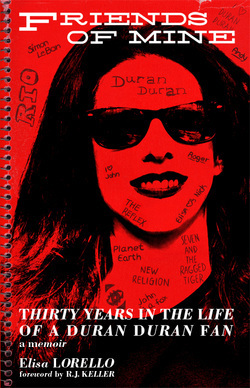 I usually don’t get too personal on my author page posts, nor do I typically accept friend requests from “fans” or readers. For example, I don’t share photos of family or friends, or talk about my relationship unless it’s the subject of a blog post. However, I made an exception when I recently got engaged and shared the news on my author page. Interestingly, that post got more traffic than any other, with the exception of a photo of John Taylor from Duran Duran holding a copy of Friends of Mine (and later one of both he and Simon Le Bon checking out the cover), so I think an occasional personal post is a good thing. (I suppose it helps that my fiancé is also an author; the nice thing is that some of my readers have checked out his books, and his have checked out mine.)
I usually don’t get too personal on my author page posts, nor do I typically accept friend requests from “fans” or readers. For example, I don’t share photos of family or friends, or talk about my relationship unless it’s the subject of a blog post. However, I made an exception when I recently got engaged and shared the news on my author page. Interestingly, that post got more traffic than any other, with the exception of a photo of John Taylor from Duran Duran holding a copy of Friends of Mine (and later one of both he and Simon Le Bon checking out the cover), so I think an occasional personal post is a good thing. (I suppose it helps that my fiancé is also an author; the nice thing is that some of my readers have checked out his books, and his have checked out mine.)
I used to be way more involved on Twitter, but I’ve done so much traveling this year that I really haven’t devoted much time to it. Twitter needs to be a give-and-take endeavor. I can’t just tweet and not engage with others, and it’s that part I haven’t had time for—scrolling through the feed, seeing what others have to say, and responding to/conversing with them. Moreover, lately I feel as if I really haven’t had much to say. It kind of bums me out a little because I’ve connected with some great people on Twitter, made a couple of lasting professional contacts, and it’s been an effective promotional outlet in terms of that aforementioned making connections that result in others talking about my books rather than my directly selling them. I do hope to reclaim my Twitter mojo in 2016.
What is your most painful rejection story, and what did it teach you?
I take rejection in publishing much better than I did in relationships or jobs. Go figure. I attribute the way I learned to handle rejection in publishing from having grown up with professional musicians. One incident in particular stands out. Back in the mid-eighties, my eldest brother sent a demo of songs (co-written and recorded with another brother) to one of his musical idols, a renowned musician/songwriter/producer, in the hope that this artist would produce an album, leading to a recording contract for/with both brothers. The artist sent a handwritten letter in response praising the demo and asking for more songs. My brother followed up and delivered another demo, and thus received a second letter, this one telling my brothers that they were more than capable of producing themselves.
That final response was equal parts validating and heartbreaking—the praise validated my brothers’ talent, but the rejection left them back at square one.
My eldest brother continued to work as a session musician, songwriter, producer, and audio engineer, and he is credited on records that have gone gold and platinum. And although he never attained the stardom or the level of wealth or success as other artists, he has been able to make a living and is a master of his craft. Today success looks and means something very different to him than it did thirty years ago.
Rejection is a part of the writing and publishing process. Dare I say, it’s business. I’ve received rejection in the form of literary agents and editors turning down manuscripts, one-star reviews, and disappointing sales, some more stinging than others. It’s not that the rejections I’ve had completely rolled off my shoulders and didn’t affect me at all; it’s just that I never let any rejection limit or define me. I assessed each one, learned what I could from it, and planned my next course of action. Witnessing my brother’s experience taught me that. It also taught me to keep my focus on the work and the craft. The talent was there. The work was good. Keep making it better. Make good contacts. Keep doing what you do, and do it well. Persevere. Make a plan. Define success on your own terms. It’s okay to shape that definition as you go along.
You didn’t bother with queries for your second book, Ordinary World, but went straight to self-publishing. How did Lake Union happen?
At the time I finished Ordinary World (the sequel to Faking It), I had decided not to query literary agents for it because I didn’t know how to query about a sequel to a book that hadn’t yet seen any success. By then (2009), I had self-published the print edition for Faking It and sold approximately fifty copies in six months.
During the summer of 2009, I followed the lead of a friend who had uploaded his books to Kindle, charged 99 cents, and watched them go like hotcakes. I published Faking It to Kindle in June, and Ordinary World in October. Ordinary World sold fifty copies in the first month, a major accomplishment at the time. The numbers kept going up. That Christmas, a Kindle was the hot gift of the season. People had these elaborate devices but no money to spend on ebooks, so they sought out good-but-cheap books. After doing a Google search months after the fact, I discovered that Faking It had topped many lists of recommendations for the good-but-cheap category. A snowball effect happened, and by the end of January, Faking It had catapulted to number six on the Kindle Bestseller List (although at the time, Amazon didn’t distinguish free books from paid books, so the first five books ahead of mine were free). Ordinary World was in the top twenty-five. Both books collectively sold something like 16,000 copies in mere days. It was mind-boggling and massively exciting.
I have a knack for identifying something I desire or want to achieve, visualizing my attaining it, and then setting out to acquire or achieve it. Sometimes it doesn’t come in the form I originally expected or intended or imagined it, or in the time frame, but I’ve never been disappointed.
By June 2010, I’d raised the price of both ebooks to $2.99, and even though my sales totals had dropped, I was remaining steady in terms of royalties. AmazonEncore, Amazon Publishing’s first imprint, contacted me. My now-retired editor, Terry Goodman, praised Faking It and said they wanted to acquire it. Around that same time, an imprint of Simon & Schuster had also contacted me. Again, my mind was just completely blown. The novel I had once doubted would appeal to anyone other than rhetorical geeks who liked When Harry Met Sally was in demand by publishers! And they came to me! No queries or pitches or proverbial knocks on the door. It was a dream come true. But it was also the result of all the work and investment I’d put into getting my book published and into the hands of readers. That was validating.
However, it didn’t take long to see that AmazonEncore not only expressed genuine interest, but also was moving in a direction that was more innovative and aggressive than traditional publishers. I used to call AmazonEncore “the reverse Wizard of Oz”—rather than the powerhouse being up front and the little guy behind the curtain, AE had functioned like a small press with the mighty Amazon powerhouse behind them. They wanted to keep the focus on ebooks, but also give the author as much attention as possible. They also wanted to keep the prices of my ebooks low, whereas the traditional publishers were still insistent on pricing ebooks between ten and fifteen dollars. I found those things rather appealing. I thought the AE model was the perfect blend of self- and traditional publishing. Meanwhile, the people at the Simon & Schuster imprint were slow to return calls, vague in their plans for my book, and overall unenthusiastic. Whereas AE wanted to work with me, S&S seemed only to want to acquire me.
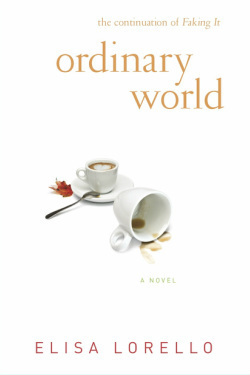 By Spring 2011, AmazonEncore re-released Faking It and Ordinary World (both of which topped the Kindle Bestseller List a second time), and published Why I Love Singlehood. I had such a great time breaking that news to my WILS co-author, Sarah Girrell: “You’re about to become the envy of aspiring authors everywhere: you’ve just gotten a publishing contract and you didn’t even have to write one query letter.” Rather than acquire a literary agent, I decided to hire an entertainment lawyer.
By Spring 2011, AmazonEncore re-released Faking It and Ordinary World (both of which topped the Kindle Bestseller List a second time), and published Why I Love Singlehood. I had such a great time breaking that news to my WILS co-author, Sarah Girrell: “You’re about to become the envy of aspiring authors everywhere: you’ve just gotten a publishing contract and you didn’t even have to write one query letter.” Rather than acquire a literary agent, I decided to hire an entertainment lawyer.
Since then, Amazon Publishing has grown and expanded its imprints, and I was transferred to Lake Union Publishing, where I continued to work with Terry until his retirement, and other terrific editors. My experience with the entire Lake Union team has been positive, and I hope to continue working with them. Signing with a publisher definitely made my ego feel good in terms of status, and it does come with some perks that self-publishing doesn’t give you. On the other hand, I am very proud of my self-publishing roots, and it remains a viable option. Self-publishing teaches you the ins and outs of the business from every angle, and that was invaluable to me. Plus it gives you a level of control that you won’t have with traditional publishing.
Up until recently, I didn’t believe I needed a literary agent when I’d had such a good working relationship with Lake Union and felt confident my lawyer was taking good care of me. Occasionally I looked into someone to represent me for film/television acquisition, but those interests fizzled. However, this past summer I was introduced to a literary agent rather kismetly (is that a word?), and after a several face-to-face and phone meetings with her, I decided that I’ve reached a point in my career where a literary agent would be quite helpful. It’s already been a great relationship, and I’m so excited about the stuff that is coming down the pike as the result of our collaboration.
Some of the most emphatic advice any writer receives prior to self-publishing, and now even prior to querying agents, is to hire (or otherwise secure) an editor. When you were self-publishing, you edited your own novels. When can a writer reasonably trust her- or himself to be both writer and editor?
When it comes to editing one’s own work, my advice is: “Do as I say, not as I did.” In other words, don’t edit your own novel! I think if a writer also makes a living as a professional editor, then perhaps s/he can trust her/himself to self-edit. But I think even professional editors would hand over their manuscripts to a trusted fellow editor.
When I first self-published, there was so much I didn’t know, and I learned as I went. A lot of things I did then I could and would never get away with now, nor would I want to. I had little to no budget and believed I was good enough to self-edit. How wrong I was. I have an above-average grasp of grammar and mechanics, but I’m not a grammarian. I learned that when I saw the copyedited corrections on Faking It prior to its re-release. I had also insisted on breaking some grammar rules that I had thought were clever in style, but a good editor knows which rules to break and how to do them successfully. I think a good writer knows, too. I got better at it as I learned from my editors. For example, before Why I Love Singlehood was published, I rushed the proofreading and stubbornly overrode the editors’ suggestions on a few things. I regret it constantly and wish we could give it one more sweep from an editor.
What lessons have you learned in your experiences with self- and traditional publishing that have had the greatest impact?
One is to act with professionalism and integrity. I’ve seen authors implode on social media by responding defensively to negative reviews, making unrealistic demands on agents or editors, blaming bookstore owners for poor event turnouts, and just behaving badly in general. Early on, when I was querying literary agents, one expressed interest and invited me to follow up. Thus, I followed up. And followed up. And followed up. My go-getter spirit worked against me, and, as a result, shredded any hope of working with this particular agent. It was a valuable lesson: Following up with a professional reminder that the agent invited you to do so is okay, but making a pest of yourself is not. If the agent has moved on, then you must too.
When self-publishing, you must hold yourself to the highest standards. A reader or bookseller shouldn’t be able to tell the difference between a self-published book and a traditionally published book. The editing and interior/exterior design must be top of the line, and the story must be well told. Also, telling a good story and honing your craft must always come first. When aspiring authors ask me to assist them with publishing options before they’ve finished their manuscript, I politely tell them to finish it, make it publish-ready, and then contact me.
Finally, one needs to be able to release all attachments to a book’s performance. There’s always an X-factor as to why some books sell and others don’t. Of course, it’s always disappointing when a book that showed promise doesn’t perform the way you’d hoped. But I take a cue from President Bartlet (The West Wing) and say, “What’s next?” I have to move on. No matter what, I want to walk away from any publishing experience knowing I wrote a novel I was proud of and that I did the best I could to bring it to readers.
Thank you, Elisa.
December 15, 2015
The Myth of the Everyreader

by takomabibelot | via Flickr
Note from Jane: In today’s guest post, editor and writing coach Rebecca Faith Heyman (@rfaitheditorial) discusses myths surrounding appealing fiction, YA novels, and readership.
Authors are storytellers—everyone knows that. But authors are also voracious consumers of stories, since language is our medium for the discovery of meaning. The stories we tell ourselves are powerful, capable of framing how we see ourselves and the world.
Lately, I’ve noticed what I consider a dangerous story beginning to take root in the author community, concentrated in but not exclusive to young, first-time novelists. I’ve not yet heard the myth given a name, in part because it’s too new to have emerged fully in our industry’s consciousness, but I’ve come to think of the insidious tale as the Myth of the Everyreader.
To understand what the Everyreader is, and why the idea of it is so detrimental to author success, I want first to tell you about how I became aware of this myth’s growing power and pervasiveness.
Just last week I received a query from an author seeking editorial services for his first manuscript. When I asked him to identify his book’s audience, he told me: “Readers between the ages of fifteen and thirty-five, and basically anyone who has ever experienced heartache.”
What struck me wasn’t this author’s grand designs, but rather that they aren’t unique. That same week, I heard from an author whose market is “readers age fourteen to twenty-five,” and another who just wants to write “for boys.”
Perhaps it’s time to state an obvious truth: “Everyone” is not a target audience. In fact, “everyone” is not a target anything. A piece of common writing wisdom teaches that first drafts are for the author, and all subsequent drafts are for the reader; authors who believe in the existence of an ageless, genderless Everyreader are all but ignoring the vital presence on the other side of the page. Who exactly is reading your book? If you think the answer is “everyone,” you’re setting yourself up for frustration and failure.
Rise of the Myth
I’d venture a guess that most authors writing for the Everyreader have been raised on a steady diet of contemporary, upper-YA crossover successes—books intended for readers age twelve to seventeen that have seen major play from adult readers too. Titles from authors like John Green, Rainbow Rowell, J.K. Rowling, Jandy Nelson, and Suzanne Collins qualify as YA crossover, since their readerships have transcended the books’ intended audience of young readers.
Conditions are ripe for the world to tell itself a story—a myth—about these crossover successes, in an effort to both explain and replicate them. After all, every author mentioned in the previous paragraph has optioned at least one novel for film; Warner Bros. bought the option for Nelson’s I’ll Give You the Sun before the book was even released.
So now we have young authors whose heads are filled with great YA literature, fantasies about movie premieres, and the strong Millennial conviction that anything is possible. To them, it appears that everyone is reading YA—so why shouldn’t they write books designed for everyone?
What most of these authors fail to realize is that the crossover successes they’re trying to emulate were written for a distinctive audience. Who we write for has so much to do with what and how we write, which is why authors can’t afford to believe in an audience that doesn’t truly exist.
Myth vs. Reality
Though YA crossover successes seem to be read by everyone, the books themselves are aimed at a narrow sliver of the market. Many of the young authors I hear from are concerned about being pigeonholed as YA authors, due to yet another (far more ridiculous) myth: that writing YA is easier, or otherwise “less than” writing adult fiction. These authors seem to fear that writing YA will make them the child sitcom stars of the literary world, destined for spectacular failure as they grow up to write books meant for adults.
Let’s put this myth to bed once and for all, okay? Writing YA is not easy, nor is it easier than writing for adults. One doesn’t “graduate” from writing YA; it is not a remedial practice.
In a 2014 interview with NPR about her YA novel Belzhar, Meg Wolitzer—an author whose previous releases were aimed at adults—cited the “immediacy” of YA as a defining factor of the prose, in contrast to more “language-focused” adult fiction. What I like about this distinction is that it doesn’t privilege one over the other; evoking immediacy is not better or worse than teasing out nuances of language, and of course these features of good writing are not mutually exclusive.
For whatever reason, I’m finding that authors who believe in the Everyreader also believe they must show the world what serious, adult writers they are—even when the stories they want to tell are YA stories. The common approach is to introduce a main character slightly older than the typical YA protagonist’s sixteen years, but transpose all the same motifs of first love, rebelling against authority, and discovering identity into the plot. Prose in these manuscripts is still marked by the immediacy Wolitzer cites, and characters demonstrate the same emotional volatility we find from their younger counterparts. This is a problem. Sixteen-year-olds can be forgiven for acting on pure emotion, and some might even be endearing for it (Katniss Everdeen, anyone?). But eighteen-year-olds? Characters in their twenties? Like the rest of us, these figures must acquiesce to the passage of time and demonstrate at least some of the maturity commensurate with ages beyond adolescence.
I believe an author’s aversion to declaring herself for YA, or her insistence on denying the youthfulness of her characters, ironically stems from her own immaturity. If I write for adults, she tells herself, they might just think I am one. But this once again misidentifies why a book comes to address the audience it does.
Just like authors can’t write for an ambiguous Everyreader, they likewise can’t write exclusively for themselves. The real magic of a book happens when an author’s words and a reader’s mind make something new: page as telepathic intermediary. How can authors accomplish this delicious symbiosis if we’re hung up on self-consciousness? We have to bypass our fears of being judged or ridiculed and embrace the audience who will love us just as we are. If I didn’t know better, I’d say that sounds like the core plot of more than one YA novel.
Myths Aside
Identifying and writing to a specific audience will help authors write authentic, compelling prose. But there’s a far more pragmatic reason to know your audience. “When I take a project on,” says agent Emma Patterson of Brandt & Hochman, “it’s crucial that I can see who the audience will be. I have to determine which editors at houses tend to work on books for that audience, and convince those editors the audience is fully apparent. If I can’t see that audience or the voice is inauthentic in some way, there’s no way I’m going to be able to convince an editor to see things differently.”
When authors write to “everyone,” they are leaving an ambiguous gap at the core of their texts that could and should be filled with intention and authenticity. The difference between throwing something away and playing catch is audience. Your words need to land somewhere—and you need to know where that is before you write.
I asked Laura Chasen, an editor at St. Martin’s Press, about what makes a great crossover. “It’s all about connecting at the gut level. Whether or not a story is peppered with Hogwarts, punk music, or cyborgs is really superfluous. A truly successful crossover is all about depth of character and nuanced portrayal of relationships—the innards of any good novel.”
It should come as no surprise that what makes YA spectacular is the same stuff that makes any book captivate an expansive audience. Authors who dream of blockbuster success would do well to remember that.
Happily Ever After
Joseph Campbell said that “Myths are the stories of our experience of life.” For an up-and-coming generation of authors, that experience includes a Golden Era of YA literature that has transcended the supposed confines of the form. While it’s tempting to mythologize this phenomenon, we can’t lose sight of the fact that YA’s success is just the happy convergence of immensely talented authors around a singular reading audience. Authors hoping to ride the gravy train of YA books with mass appeal should keep their audiences dear to mind, and focus on what hopeful authors in all genres have focused on since forever: writing great books.
Note from Jane: Rebecca is the founder of The Work Conference, an inaugural boutique writers’ conference scheduled for March 2016 in New York City. Attendance is extremely limited, but unagented authors of adult or YA fiction with a literary or upmarket feel in any genre are encouraged to apply by the Dec. 31, 2015 deadline. Readers of this blog receive a discounted application.
December 14, 2015
How to Use Facebook Contests & Giveaways to Build a Fan Base

by jamesbluntbook | via Flickr
Note from Jane: In today’s guest post, social media marketing expert Chris Syme (@cksyme) discusses how to use Facebook contests and giveaways to turn fans into super fans.
There’s an old online myth that says if you give something away, you will only attract people who are looking for free stuff—fans who will never pay for anything. But, like many marketing myths, this one has no legs. As a matter of fact, contests and giveaways have the opposite effect according to much of the consumer research we see today.* Well-timed Facebook contests and giveaways can create a reciprocal relationship with your fans. If you give them true value, they feel a sense of connection and responsibility to pay you back, so to speak. The value you offer can come in the form of good books, good online content, or, as we’ll look at in this post, giveaways and contests.
First Things First: Know the Rules
Facebook is picky about how you run contests and giveaways. They will not let you promote your page by asking people to share contests on their personal profiles or tag people as a form or condition of entry. You can ask people to share, but it can’t be how they enter the contest. Facebook supports a number of apps that can run your contest legally, including this very basic and free app for simple contests. There are also a number of good apps you can buy that run different types of contests, but for the purposes of this post, I’ll focus on how to use contests to engage fans and build loyalty.
The Journey to Super Fandom
You may have seen variations of the customer journey before, but I have illustrated the stages to super fandom by using a simple target. Our goal is to move fans into the bulls-eye.
It’s a good idea to run different types of contests each year and plan them on a regular calendar. You want to appeal to all levels of fans. Some contests have a promotive value and others have a reward value. Here are some of the basic types of contests along with their goals and target Facebook audience.
.tg {border-collapse:collapse;border-spacing:0;}
.tg td{font-family:Arial, sans-serif;font-size:14px;padding:10px 5px;border-style:solid;border-width:1px;overflow:hidden;word-break:normal;}
.tg th{font-family:Arial, sans-serif;font-size:14px;font-weight:normal;padding:10px 5px;border-style:solid;border-width:1px;overflow:hidden;word-break:normal;}
.tg .tg-e150{font-size:14px;font-family:Georgia, serif !important;;vertical-align:top}
.tg .tg-x4b5{font-weight:bold;font-family:Georgia, serif !important;;background-color:#73ea4c;color:#000000;text-align:center;vertical-align:top}
.tg .tg-oifs{font-family:Georgia, serif !important;;background-color:#efefef;vertical-align:top}
.tg .tg-k4q0{font-family:Georgia, serif !important;;vertical-align:top}
Contest
Goal
Target Audience
Location
Book launch contests and giveaways
To sell more books
All fan groups
Facebook page
Page building
To increase the number of casual fans; discovery
People who are not yet fans of your page
Facebook page and boosted posts
Fan engagement
To move fans to the next level of fandom
Casual and engaged fans
Facebook page and group
Thank-you giveaways
To reward fan loyalty
Engaged and super fans
Facebook group
Book Launch Contests
When you promote a book for sale, you should be aiming at all fan groups. Even your super fans want to be remembered and reminded. This is probably the most familiar formula for most authors. It may be in the form of a launch party.
I do suggest that you run your giveaway over a number of days rather than just one night on launch day. Having a multi-day party with three possible prizes the first night and then one on each of the following days will keep the chatter going.
Don’t be afraid to ask people to share with friends. Your super fans will do this without being asked. You may want to use secondary goals of building your email list or promoting your Facebook group (the more intimate and personal location for raving fans). If you have both a group and a Facebook page, I would keep launch promotions on your page and refer group members there to participate. Fan group pages are usually closed, and you want your new book to have maximum exposure.
Page-Building Contests
You can use giveaways to build your fan base as well. I recommend you run this type of giveaway a couple times a year, tops. Page-building contests help you get people into the first stage: casual fans. These types of giveaways rely on shares. Ask people to share—you can’t make it a condition of entry, but you can let them know what your contest aim is (to get new fans) and ask them to partner with you.
Boosted posts can help as they will help you reach a larger percentage of your fans than Facebook normally allows. I’ve had much success in this type of contest using a target number of fans I want to reach (say an increase from 800 to 1100 in a defined span of time) and offer prizes at each milestone of 50 new fans. Don’t let these types of contests drag on forever—three to four weeks, tops. You will be surprised how motivated your fans will get to help you reach a milestone. There is more information on using Facebook ads for promotions in my new book SMART Social Media for Authors.
Fan Engagement Giveaways
These giveaways are designed specifically to move people to the next level of fandom. This is a perfect way to get people to join your exclusive Facebook group or subscribe to your newsletter. I have also used this type of giveaway inside a closed Facebook group to invite people to join an advance-reader team. One author I work with offers a canvas tote bag to all her advance readers. You can use this gift incentive to get new team members with a two-day promotion in your group or in a monthly newsletter. The cost is minimal for what you gain—new reviewers. I would run this type of giveaway probably two times a year.
Thank-you Giveaways
I think it’s a good idea for all authors to have an annual thank-you giveaway promotion—no strings or promotions, just thanks. One author I know runs an annual 12 Days of Christmas promotion where she puts together 12 gift packages and posts a question or poll once a day beginning on December 25. A random winner is chosen daily. This promotion takes place only in her closed Facebook group, but she promotes the opportunity to join the group in her newsletter and her Facebook page before the giveaway starts. This year she has collected books from author friends in her same genre (along with some other goodies) and is using those for her 12 giveaways. In exchange, she has offered books to all the cooperating authors for their future giveaways.
Facebook contests can help you build raving fans: people who share your social media posts, buy all your books, review and share them, and recommend them to others. If you plan your contests out on an annual calendar, each contest will have a specific purpose and work to move your fans from just being casual acquaintances to super fans.
* Here are some resources with research and data about creating a reciprocal culture with giveaways: The Content Code by Mark Schaefer and 5 Ways Companies Win by Giving Stuff Away from Time Magazine online.
For more advice from Chris Syme (@cksyme), check out SMART Social Media for Authors or visit cksyme.com.
December 11, 2015
Do Men Receive Bigger Book Advances Than Women?

by Jason Mrachina / Flickr
Note from Jane: I originally wrote this post for the Scratch Magazine blog in May 2014. To continue to make the information available, I’ve republished it here at my site.
In a recent Twitter conversation, I was asked if Scratch could shine a light on book advances, and research whether a disparity exists in book advances paid to men versus women.
This is nearly an impossible task. Most authors never disclose the amount of their advance, and agents/publishers are not forthcoming either. Such contractual terms are treated as confidential. Even if the figures were readily available, it’s very difficult to compare advances due to:
author sales history
the sales history of the genre or category
what rights or territories were sold
the size of the publisher that bought the book
the impact of auctions, and …
… the intangibility of the product. A book advance takes into consideration the quality of the book, “buzz,” the author’s long-term career promise, the author’s pre-existing fan base, and more. These are judgment calls that affect the advance but aren’t directly reflected in a profit-and-loss statement.
However, it’s possible to consult one resource that offers directionally useful information: the Publishers Marketplace deals database. PM has been collecting information on book deals self-reported by agents and publishers since 2000. Key word: self-reported. It is not a catalogue of all publishing deals made, but it’s the best insight we’ve got. Many publishing insiders subscribe to the service, which includes a weekday e-mail newsletter called Publishers Lunch, a members database, and other excellent features. (I’ve been a subscriber for many years.)
Getting to an Apples-to-Apples Comparison
To try and answer the question of whether males or females receive higher advances, I narrowed my deal analysis to the following:
Debut novelists only, and only those who had never before published a book in any genre and therefore had no sales history
Only US-based deals; no foreign/international deals or rights
I limited my search to deals reported between January 1, 2010, and May 16, 2014.
A few caveats:
I did not differentiate between single and multi-book deals. They are each counted as one deal.
If I could not determine the gender of the author, that deal was not counted. (I further researched authors whose names were gender neutral.)
If the book was co-authored by a male and a female, I did not count it.
The first two charts (Gender of Author + Total Debut Novel Deals) reflect the total number of deals that satisfied my criteria (392) during the time period. The rest are slices of that data, looking at specific genres.
Important: Not all deals reported to PM include an indication of the advance. So I only counted deals where that information was provided. The rest were ignored. Also, the advance is reported only as part of a range. Those ranges are:
Nice deal: up to $49,000
Very nice deal: $50,000–$99,000
Good deal: $100,000–$249,000
Significant deal: $250,000–$499,000
Major deal: $500,000 and up
Gender of the Author
The following chart shows the gender breakdown of debut novel authors in deals reported to Publishers Marketplace (2010–2014). Again, this only reflects those reports with information on the size of the deal.
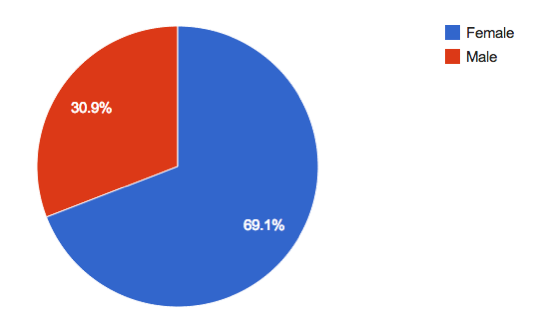
I was curious what the percentage would be if I tallied the genders of authors for every debut novel deal reported to PM, regardless of whether the size of the advance was indicated. I counted deals reported in 2014 so far, and the split was very similar: 70.8% female versus 29.2% male. Why do women dominate in these debut deal reports? I don’t know.
Total Debut Novel Deals (all genres)
As reported to Publishers Marketplace (2010–2014), and only those reports with information about the size of the deal.
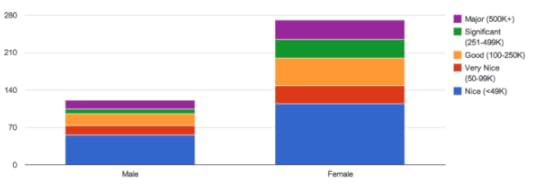
click to enlarge
Percentage of Total Deals by Advance Range
Nice
Very Nice
Good
Significant
Major
Male
46.28%
14.05%
18.18%
7.44%
14.05%
Female
42.07%
12.55%
19.19%
12.55%
13.65%
Debut General Fiction Deals
As reported to Publishers Marketplace (2010–2014), and only those reports with information about the size of the deal.
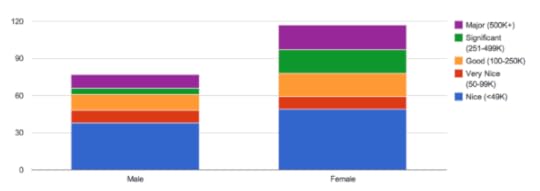
click to enlarge
PM has a specific category for reporting debut novel deals—Fiction: Debut—which is not genre specific. So I’m using the term “General Fiction” as a catch-all category where no specific genre was identified or apparent in the report. I also searched for the keyword “debut” to uncover all debut deals reported, since some debut novels are reported under specific genres, not under Fiction: Debut.
Debut Young Adult Deals
As reported to Publishers Marketplace (2010–2014), and only those reports with information about the size of the deal. Pro tip: Be a woman writing YA fiction to sell your next book for a large advance.
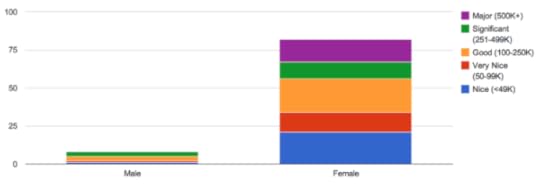
click to enlarge
Debut Middle Grade Deals
As reported to Publishers Marketplace (2010–2014), and only those reports with information about the size of the deal.
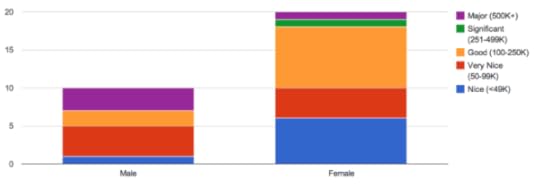
click to enlarge
Debut Children’s Picture Book Deals
As reported to Publishers Marketplace (2010–2014), and only those reports with information about the size of the deal.
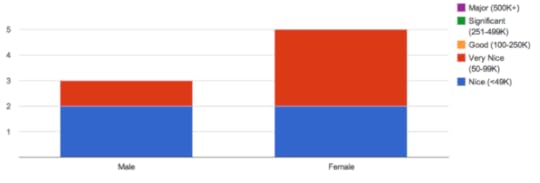
click to enlarge
Debut Women’s/Romance Deals
As reported to Publishers Marketplace (2010–2014), and only those reports with information about the size of the deal. There are men who write romance, but often under female pen names. I did not research whether the women landing debut romance novel deals were really women.
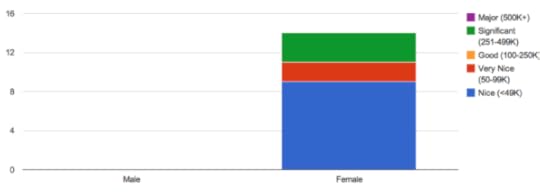
click to enlarge
Debut Thriller Deals
As reported to Publishers Marketplace (2010–2014), and only those reports with information about the size of the deal.
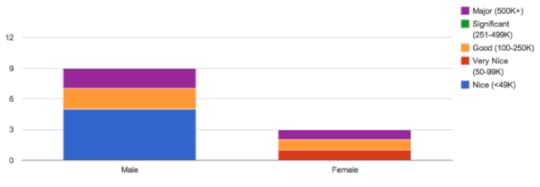
click to enlarge
Debut Science Fiction & Fantasy Deals
As reported to Publishers Marketplace (2010–2014), and only those reports with information about the size of the deal.
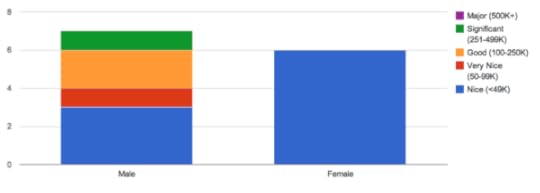
click to enlarge
If there is a potential case of advance disparity in publishing, this might be it. Still, this does not mean there weren’t any female authors in SFF who didn’t receive higher advances or in the same numbers as the men; they may not have been reported.
Debut Mystery/Crime Deals
As reported to Publishers Marketplace (2010–2014), and only those reports with information about the size of the deal.
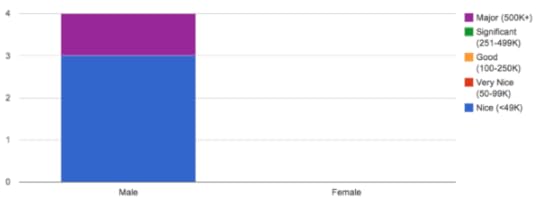
click to enlarge
Again, keep in mind this does not mean there weren’t any female debut authors in the mystery/crime genre from 2010–2014. Rather, there was no financial information associated with their deals, and they may not have been reported in the first place.
Debut Digital-First/Only
As reported to Publishers Marketplace (2010–2014), and only those reports with information about the size of the deal.
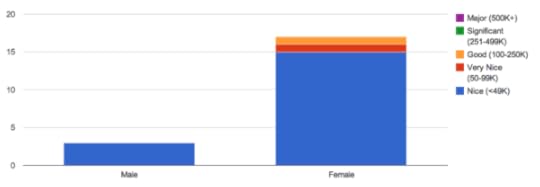
click to enlarge
This category includes all genres, but indicates indicates books from digitally-focused imprints, who generally publish digitally only or digital first. Since categories such as women’s fiction/romance do well in digital formats, and there are a high number of digital-only imprints in that particular market, that may be the reason for more female authors here.
Other Types of Deals
I also counted one nice deal and one good deal for “new adult” novels by female authors (“new adult” is similar to young adult), and five nice deals for female authors in the inspirational novel category.
Your Interpretation?
What’s your take on this data? What surprises you—or not? Let me know in the comments.
Many thanks to Michael Cader of Publishers Marketplace for granting permission to share this data from the deals database, and to both him and Sarah Weinman for reviewing this post in advance of publication.
December 8, 2015
Geek Out With Me: LIVE Chat on Product Hunt!
Those of you who follow my Electric Speed newsletter have seen me discuss and link to ProductHunt on numerous occasions. It’s a really cool website and community that’s focused on surfacing new products, books, podcasts, games, and more. People basically share and geek out about the latest things they love, whether they’re apps, services, or tech creations.
Product Hunt features live chats every week, and I was thrilled to be a live chat guest on Thursday (December 10) at 3 p.m. Eastern. Read the entire conversation.
You might also want to check out some of my ProductHunt collections for writers and entrepreneurs.
Jane Friedman
- Jane Friedman's profile
- 1882 followers












